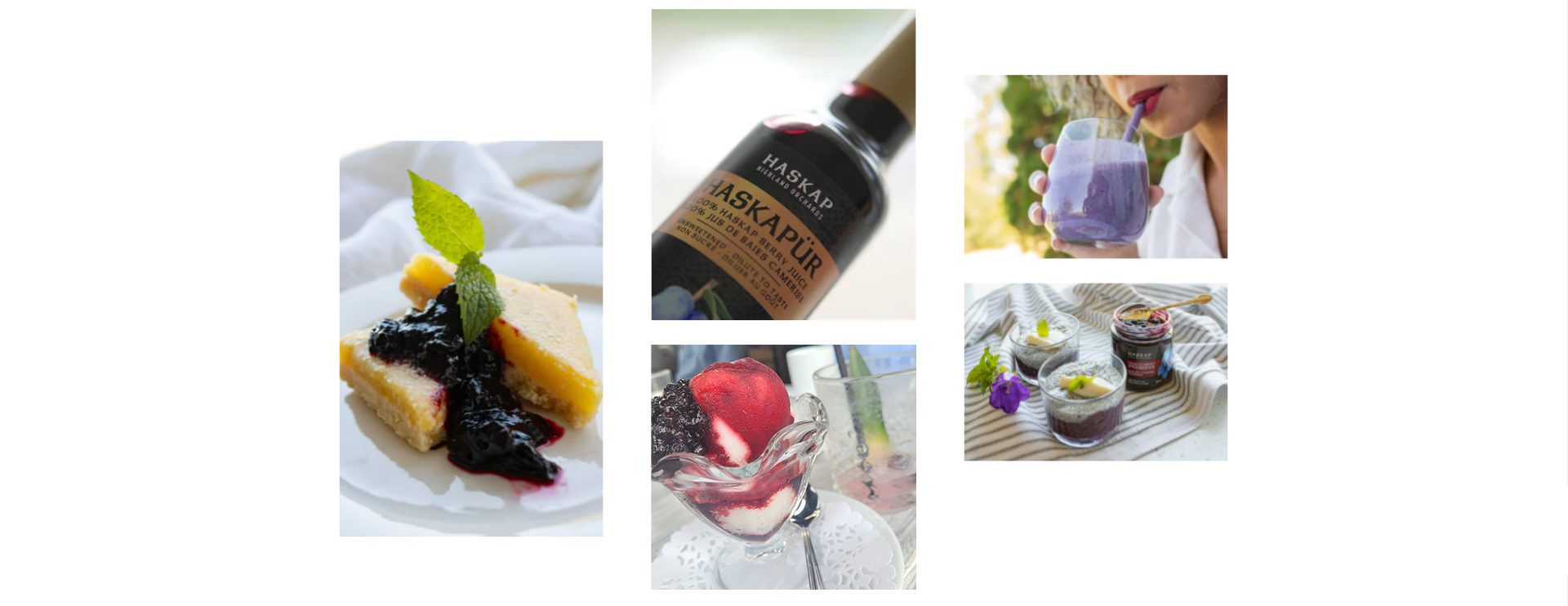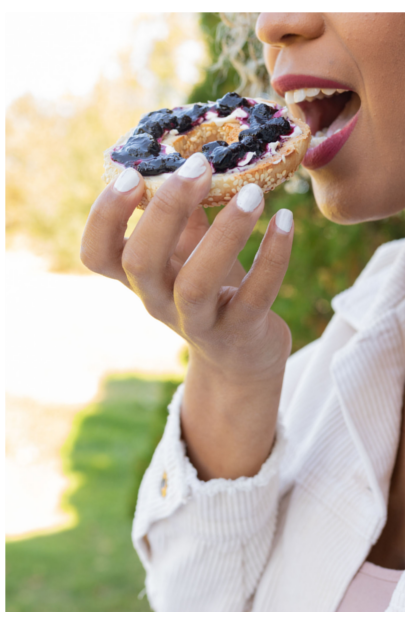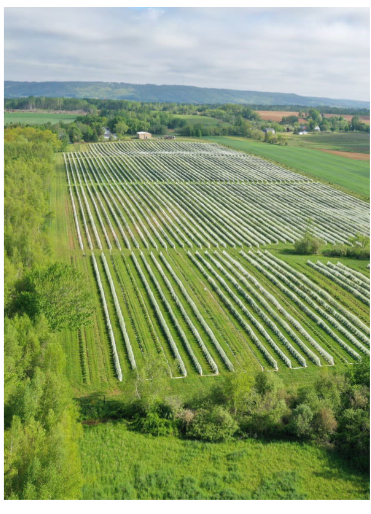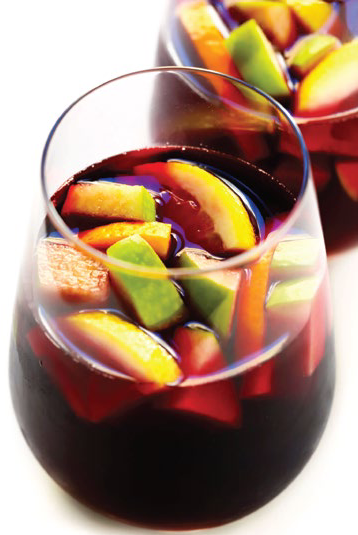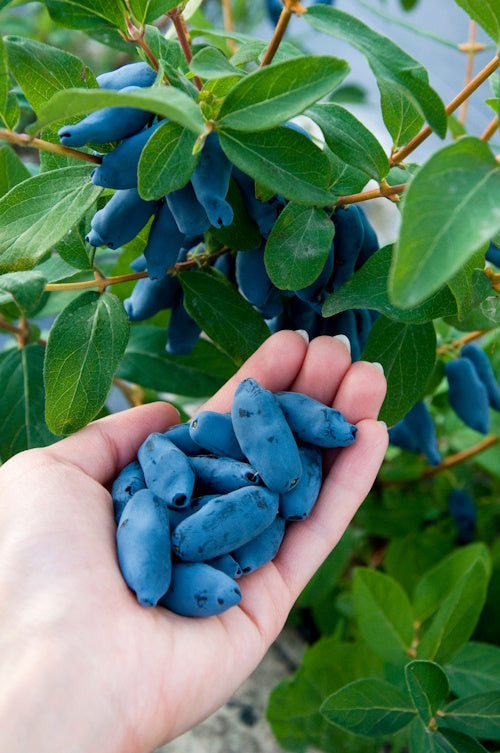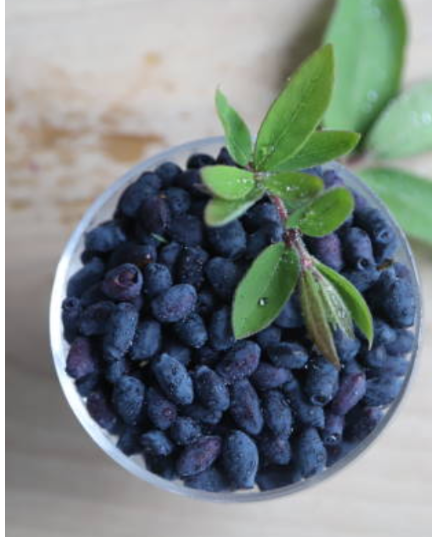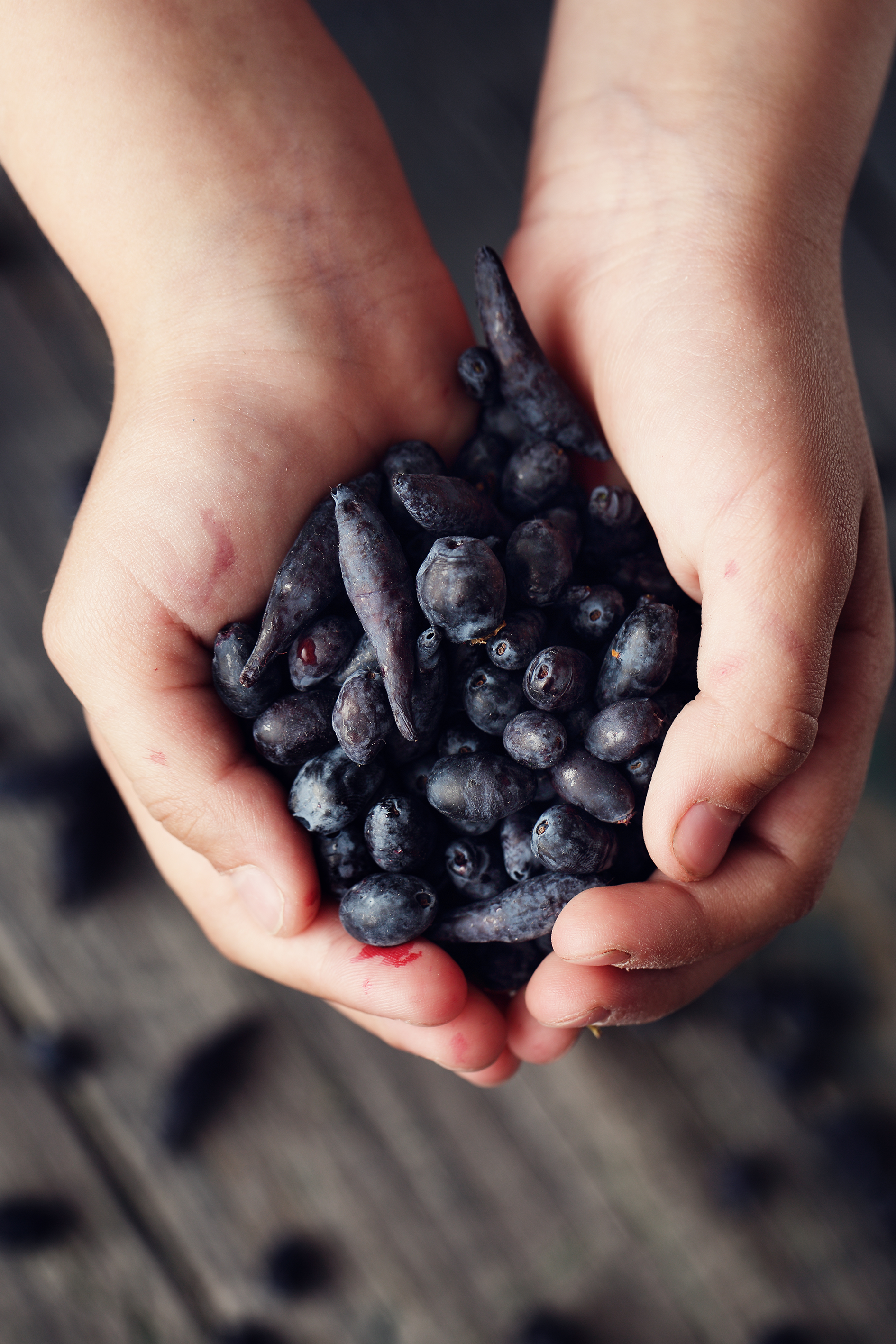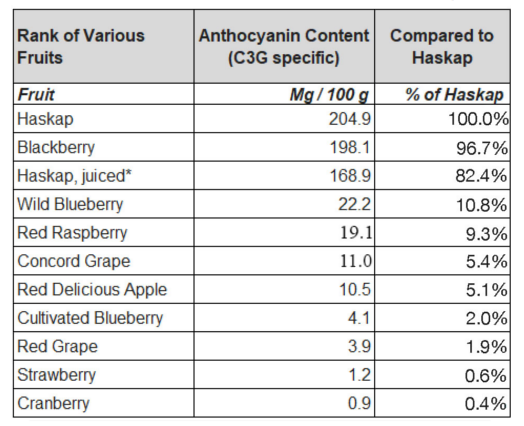
Nature Delivers
Haskap berries are also naturally super rich in antioxidants - the powerful compound that seeks out free radicals in our cells and renders them harmless.
SCIENCE CONFIRMS WHAT OUR BODIES HAVE BEEN TELLING US ALL ALONG: DELICIOUS HASKAP BERRIES ARE BURSTING WITH MASSIVE NUTRITIONAL BENEFITS.
And we mean massive!
Just one serving (100g) of Haskap offers you double the Vitamin A, and more Vitamin C than an Orange!
Haskap also has higher contents of calcium, iron, phosporus and potassium than blueberries, oranges, grapes and apples. And that's just the start!

IMMUNITY BOOST BENEFIT
A SOURCE OF GOOD HEALTH FOR CENTURIES
Haskap berries have long been at the staple of nutritional health in Japan, a country well known for its low rate of degenerative diseases.
When the Japanese diet was closely examined, scientists found the source, an antioxidant, more specifically the anthocyanin, C3G, found in abundance in the Haskap berry.
Haskap Comes Out On Top
The most powerful of the antioxidants are the anthocyanins called C3G. Haskap has a very high content of C3G, the most potent of the anthocyanins that reduce free radicals, in-turn reducing inflammation- a key factor causing almost all degenerative diseases.
The hierarchy, from most generic to most specific, is:
Antioxidants -> Polyphenols -> Anthocyanins -> C3G.
C3G stands for Cyanidin-3-0-Glucoside.
Here's how haskap berries rank among other C3G-rich fruits:
ARE HASKAP BERRIES GOOD FOR YOU?
The deep purply-blue skin and crimson coloured flesh of Haskap berries is the source of its exceptionally high antioxidant content, which is usually measured in the lab as Polyphenols. The most powerful of the antioxidants is a polyphenol known as C3G (Cyanidin-3-0-Glucoside). Haskap’s strong production of C3G at 2049 mg/litre (compared to blueberries at 222 mg/litre) has the benefit of reducing inflammation in the body as a direct result of excess free radical elimination. That’s 9 times the antioxidant action of blueberries!!
Reported in the Canadian Journal of Plant Science , researchers presented a simplified diagram of the potential health benefits of the Haskap Berry:
-
Other forms of antioxidants that can be found in Haskap Berries are exceptionally high contents of Vitamin C and Vitamin A.
Just one serving (100 g) of Haskap Berries offers more Vitamin C than an orange, plus double the Vitamin A.
- Vitamin C is an antioxidant for the maintenance of good health and helps to support immune function.
- Vitamin A helps support eye and skin health as well as the immune system.
Haskap also has higher contents of calcium, iron, phosphorus and potassium than blueberries, oranges, grapes and apples.
Note: 5% or less is a little, and 15% or more is a lot.
-
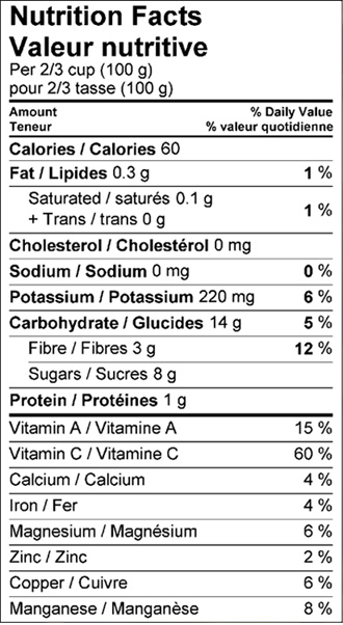
-
-
HASKAP BERRY RESEARCH PAPERS, PEER REVIEWED
Amararathna M, Hoskin DW, Rupasinghe HPV. Anthocyanin-rich haskap (Lonicera caerulea L.) berry extracts reduce nitrosamine-induced DNA damage in human normal lung epithelial cells in vitro. Food Chem Toxicol. 2020;141:111404. doi:10.1016/j.fct.2020.111404
Bell L, Williams CM. A pilot dose-response study of the acute effects of haskap berry extract (Lonicera caerulea L.) on cognition, mood, and blood pressure in older adults. Eur J Nutr. 2019;58(8):3325-3334. https://doi.org/10.1007/s00394-018-1877-9
Biswas D, Sarkar S, Silva A, D'Souza K, Kienesberger P, Rupasinghe HPV, & Pulinilkunnil T. Cyanidin-3-O-Glucoside Rich Extract From Haskap Berry Improves Glucose Homeostasis and Insulin Sensitivity in Diet-Induced Obese Mice. Canadian Journal of Diabetes. 2018 42. https://doi.org/10.1016/j.jcjd.2018.08.169
Celli G.B., Ghanem A., Brookes MSL. (2014) Haskap berries (Lonicera caerulea L)- a critical review of antioxidant capacity and health related studies for potential value-added products. Food Bioprocess Technol, published online 1st April 2014
Golba M, Sokól Letowska A, Kucharska AZ. Health Properties and Composition of Honeysuckle Berry Lonicera caerulea L. An Update on Recent Studies. Molecules. 2020;25(3):749. Published 2020 Feb 9. doi:10.3390/molecules25030749
Howatson G, Snaith GC, Kimble R, Cowper G, Keane KM. Improved Endurance Running Performance Following Haskap Berry (Lonicera caerulea L.) Ingestion. Nutrients. 2022; 14(4):780. https://doi.org/10.3390/nu14040780
Kithma A B, De Silva H, Rupasinghe HPV. Polyphenols composition and anti-diabetic properties in vitro of haskap (Lonicera caerulea L.) berries in relation to cultivar and harvesting date. Journal Food Composition and Analysis. 2020;88:103402
Rupasinghe HPV, Yu LJ, Bhullar KS and Bors B. (2012). Haskap (Lonicera caerulea): A new berry crop with high antioxidant capacity. Can. J. Plant Sci., 92: 1311-1317
Rupasinghe, H P Vasantha & Yu, Li & B., K. & Bors, Bob. (2012). Short Communication: Haskap (Lonicera caerulea): A new berry crop with high antioxidant capacity. Canadian Journal of Plant Science. 92. 1311-1317. 10.4141/cjps2012-073.
Rupasinghe, H P Vasantha & Boehm, Mannfred & Sekhon, Satvir & Parmar, Indu & Bors, Bob & Jamieson, Andrew. (2015). Anti-Inflammatory Activity of Haskap Cultivars is Polyphenols-Dependent. Biomolecules. 2015. 1079-1098. 10.3390/biom5021079.
Wu, S., He, X., Wu, X., Qin, S., He, J., Zhang, S., & Hou, D.-X. (2015). Inhibitory effects of blue honeysuckle (Lonicera caerulea L.) on adjuvant-induced arthritis in rats: Crosstalk of anti-inflammatory and antioxidant effects. Journal of Functional Foods, 17, 514-523.
ANTHOCYANIN NUTRITION RESEARCH PUBLICATIONS, PEER REVIEWED
Bertoia ML, Rimm EB, Mukamal KJ, Hu FB, Willett WC, Cassidy A. Dietary flavonoid intake and weight maintenance: three prospective cohorts of 124,086 US men and women followed for up to 24 years. BMJ. 2016;352:117. Published 2016 Jan 28. doi:10.1136/bmj.i17
Cassidy A, O'Reilly ÉJ, Kay C, et al. Habitual intake of flavonoid subclasses and incident hypertension in adults. Am J Clin Nutr. 2011;93(2):338-347. doi:10.3945/ajcn.110.006783
Cassidy A, Mukamal KJ, Liu L, Franz M, Eliassen AH, Rimm EB. High anthocyanin intake is associated with a reduced risk of myocardial infarction in young and middle-aged women. Circulation. 2013;127(2):188-196. doi:10.1161/CIRCULATIONAHA.112.122408
Cassidy A, Rogers G, Peterson JJ, Dwyer JT, Lin H, Jacques PF. Higher dietary anthocyanin and flavonol intakes are associated with anti-inflammatory effects in a population of US adults. Am J Clin Nutr. 2015;102(1):172-181. doi:10.3945/ajcn.115.108555
Cassidy A, Franz M, Rimm EB. Dietary flavonoid intake and incidence of erectile dysfunction. Am J Clin Nutr. 2016;103(2):534-541. doi:10.3945/ajcn.115.122010
Cassidy A, Bertoia M, Chiuve S, Flint A, Forman J, Rimm EB. Habitual intake of anthocyanins and flavanones and risk of cardiovascular disease in men. Am J Clin Nutr. 2016;104(3):587-594. doi:10.3945/ajcn.116.133132
Devore EE, Kang JH, Breteler MM, Grodstein F. Dietary intakes of berries and flavonoids in relation to cognitive decline. Ann Neurol. 2012;72(1):135-143. doi:10.1002/ana.23594
Grosso G, Micek A, Godos J, et al. Dietary Flavonoid and Lignan Intake and Mortality in Prospective Cohort Studies: Systematic Review and Dose-Response Meta-Analysis. Am J Epidemiol. 2017;185(12):1304-1316. doi:10.1093/aje/kww207
Kim K, Vance TM, Chun OK. Greater flavonoid intake is associated with improved CVD risk factors in US adults. Br J Nutr. 2016;115(8):1481-1488. doi:10.1017/S0007114516000519
Kimble R, Keane KM, Lodge JK, Howatson G. Dietary intake of anthocyanins and risk of cardiovascular disease: A systematic review and meta-analysis of prospective cohort studies. Crit Rev Food Sci Nutr. 2019;59(18):3032-3043. doi:10.1080/10408398.2018.1509835
Rodriguez-Mateos A, Istas G, Boschek L, et al. Circulating Anthocyanin Metabolites Mediate Vascular Benefits of Blueberries: Insights From Randomized Controlled Trials, Metabolomics, and Nutrigenomics. J Gerontol A Biol Sci Med Sci. 2019;74(7):967-976. doi:10.1093/gerona/glz047
Shishtar E, Rogers GT, Blumberg JB, Au R, Jacques PF. Long-term dietary flavonoid intake and risk of Alzheimer disease and related dementias in the Framingham Offspring Cohort. Am J Clin Nutr. 2020;112(2):343-353. doi:10.1093/ajcn/nqaa079
Wedick NM, Pan A, Cassidy A, et al. Dietary flavonoid intakes and risk of type 2 diabetes in US men and women. Am J Clin Nutr. 2012;95(4):925-933. doi:10.3945/ajcn.111.028894
Welch A, MacGregor A, Jennings A, Fairweather-Tait S, Spector T, Cassidy A. Habitual flavonoid intakes are positively associated with bone mineral density in women. J Bone Miner Res. 2012;27(9):1872-1878. doi:10.1002/jbmr.1649
EXERCISE NUTRITION RESEARCH PAPERS, PEER REVIEWED
Bowtell J, Kelly V. Fruit-Derived Polyphenol Supplementation for Athlete Recovery and Performance. Sports Med. 2019;49(Suppl 1):3-23. doi:10.1007/s40279-018-0998-x
Cook MD, Willems MET. Dietary Anthocyanins: A Review of the Exercise Performance Effects and Related Physiological Responses. Int J Sport Nutr Exerc Metab. 2019;29(3):322-330. doi:10.1123/ijsnem.2018-0088
Malaguti M, Angeloni C, Hrelia S. Polyphenols in exercise performance and prevention of exercise-induced muscle damage. Oxid Med Cell Longev. 2013;2013:825928. doi:10.1155/2013/825928
Matsukawa T, Motojima H, Sato Y, Takahashi S, Villareal MO, Isoda H. Upregulation of skeletal muscle PGC-1a through the elevation of cyclic AMP levels by Cyanidin-3-glucoside enhances exercise performance. Sci Rep. 2017;7:44799. Published 2017 Mar 20. doi:10.1038/srep44799
Somerville V, Bringans C, Braakhuis A. Polyphenols and Performance: A Systematic Review and Meta-Analysis [published correction appears in Sports Med. 2017 Aug;47(8):1601]. Sports Med. 2017;47(8):1589-1599. doi:10.1007/s40279-017-0675-5
